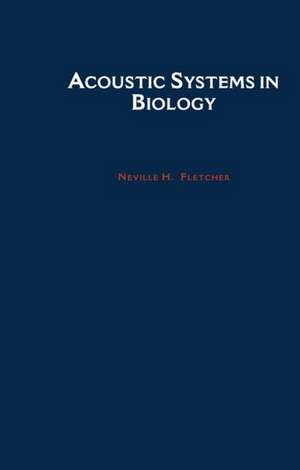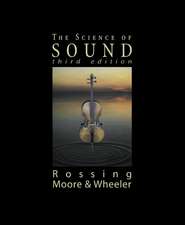Acoustic Systems in Biology
Autor Neville H. Fletcheren Limba Engleză Hardback – oct 1992
Preț: 689.09 lei
Preț vechi: 1041.69 lei
-34% Nou
Puncte Express: 1034
Preț estimativ în valută:
131.86€ • 141.00$ • 109.94£
131.86€ • 141.00$ • 109.94£
Carte tipărită la comandă
Livrare economică 07-14 aprilie
Preluare comenzi: 021 569.72.76
Specificații
ISBN-13: 9780195069402
ISBN-10: 0195069404
Pagini: 352
Ilustrații: numerous line illustrations
Dimensiuni: 162 x 243 x 31 mm
Greutate: 0.69 kg
Ediția:New.
Editura: OUP OXFORD
Colecția OUP Oxford
Locul publicării:Oxford, United Kingdom
ISBN-10: 0195069404
Pagini: 352
Ilustrații: numerous line illustrations
Dimensiuni: 162 x 243 x 31 mm
Greutate: 0.69 kg
Ediția:New.
Editura: OUP OXFORD
Colecția OUP Oxford
Locul publicării:Oxford, United Kingdom
Cuprins
Introduction; Simple vibrators; Vibrations of strings and bars; Sensory hairs and otoliths; Vibration of membranes, plates, and shells; Acoustic waves; Acoustic sources and radiation; Low-frequency network models; Low-frequency auditory models; Pipes and horns; High-frequency auditory models; The inner ear; Mechanically excited sound generators; Pneumatically excited sound generators; Signals, noise, and information; Appendices; Index.
Recenzii
The book's strength lies as a sourcebook of essential formulae and thumbnail physical descriptions ... this is a book to which all committed auditory researchers should at least have access. It is a serious attempt to educate students and researchers to the idea that some areas of physiology may be better described with the help of a little, but quite approachable, mathematics.'
The author sets out to cover the material at three levels, and to this reviewer he succeeds almost totally. The book will certainly be extremely valuable for biologists or others who study the physiology of motion sensing, hearing, and sound production in animals. The clarity of the explanations will also make it useful for anyone who wishes to understand the behaviour of sound in small spaces and in mechanical structures, whatever the application may be.'
The author sets out to cover the material at three levels, and to this reviewer he succeeds almost totally. The book will certainly be extremely valuable for biologists or others who study the physiology of motion sensing, hearing, and sound production in animals. The clarity of the explanations will also make it useful for anyone who wishes to understand the behaviour of sound in small spaces and in mechanical structures, whatever the application may be.'












